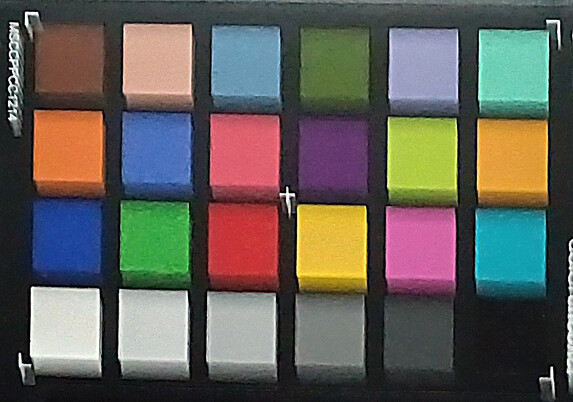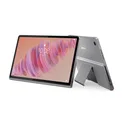Verdict on the Oppo Pad SE
The huge battery with a relatively low weight makes the Oppo Pad SE an interesting choice among medium-sized and affordable tablets. The Oppo tablet lasts over 23 hours in our WLAN battery test. Lenovo's Tab Plus manages a few more minutes, but is also significantly heavier and larger. The other competitors can't even begin to keep up here.
The bright screen without PWM flickering is also impressive. The WLAN can be fast, but is weaker when sending data. However, you can also use the 4G network for data transmission.
The 5-megapixel cameras are more of a makeshift solution.
The performance is very good for the price range: it's not enough for super demanding tasks, but you can get by without any problems in everyday life, for example you can stream 1,440p videos on YouTube smoothly. The four speakers also produce a powerful sound.
Overall, the Oppo Pad SE is a good choice for anyone looking for a tablet that is not too big and not too expensive.
Pros
Cons
Price and availability
The Oppo Pad SE is hard to find in Central Europe at the time of testing.
The tablet is only available from coolblue for 269 euros ($310).
Table of Contents
- Verdict on the Oppo Pad SE
- Specifications
- Case and features - metal for little money
- Communication and operation - Oppo tablet with cellular connectivity
- Software and sustainability - No update promise
- Cameras - Useable if you have no other camera
- Display - The Oppo manages without PWM
- Performance, emissions and battery life - tablet is fast and has a lot of endurance
- Notebookcheck overall rating
- Possible alternatives compared
Specifications
Case and features - metal for little money
The Oppo Pad SE comes with a metal chassis in a subtle gray-blue. However, the upper fifth of the casing is made of plastic to improve the reception quality of the antennas. The round camera module is located at the top center.
At the front, there is an approximately 6 millimeter thick frame around the screen, which represents a good balance between appearance and practicality, so that accidental touching of the touchscreen at the edges is rare.
The tablet cannot be twisted and the workmanship and material transitions look very high-quality.
128 GB of mass storage is standard in this price range, and the 8 GB of RAM is rather generous. There is no NFC chip and no image signal output via the USB port.
Communication and operation - Oppo tablet with cellular connectivity
Buyers will have to make do with WiFi 5, although the maximum possible transfer rates of 576 MBit/s are quite decent. On the other hand, it is much slower in the direction of transmission.
If you want to use a mobile phone tariff with the tablet, you can do so in the 4G network at most. All important frequencies are available for Central Europe, but it could be difficult to use the mobile network on longer journeys.
The touchscreen is scanned 120 times per second for inputs, and the 90 Hz screen responds very quickly. Unfortunately, there is no fingerprint sensor for unlocking, but facial recognition via the front camera is possible. Due to the low resolution, it doesn't always work the first time, especially in low light.
| Networking | |
| Oppo Pad SE | |
| iperf3 transmit AXE11000 | |
| iperf3 receive AXE11000 | |
| Huawei MatePad SE 11 | |
| iperf3 transmit AXE11000 | |
| iperf3 receive AXE11000 | |
| Xiaomi Redmi Pad SE | |
| iperf3 transmit AXE11000 | |
| iperf3 receive AXE11000 | |
| Teclast T60 AI | |
| iperf3 transmit AXE11000 | |
| iperf3 receive AXE11000 | |
| Lenovo Tab Plus | |
| iperf3 transmit AXE11000 | |
| iperf3 receive AXE11000 | |
| Average 802.11 a/b/g/n/ac | |
| iperf3 transmit AXE11000 | |
| iperf3 receive AXE11000 | |
| Average of class Tablet | |
| iperf3 transmit AXE11000 | |
| iperf3 receive AXE11000 | |
Software and sustainability - No update promise
Android 15 serves as the basis for the in-house ColorOS. This offers a very clear and well-organized system.
Oppo does not explicitly comment on the update periods for its tablets. The Pad SE should definitely still receive Android 16. An update to the May 2025 security patches will also be delivered during our test period.
Oppo does not use plastic for the packaging and prints the box with soy ink. However, there is no other information on sustainability, such as recycled materials in the device.
Cameras - Useable if you have no other camera
The Oppo Pad SE only has a 5-megapixel camera at the front and rear.
The rear camera is more suitable for scanning documents than anything else. When taking pictures, it is not very detailed and takes rather coarse pictures of the surroundings. In low light and high contrasts, the poor quality coating on the camera also causes reflections.
Videos can be recorded at a maximum of 1080p and 30fps. However, the quality is also mediocre, with the autofocus in particular causing problems.
The front camera takes passable selfies and is reasonably usable for a video call in good light.
Image comparison
Choose a scene and navigate within the first image. One click changes the position on touchscreens. One click on the zoomed-in image opens the original in a new window. The first image shows the scaled photograph of the test device.
Main cam - flowersMain cam - outsideMain cam - low light shot

Display - The Oppo manages without PWM
The tablet's 11-inch IPS screen is up to 518 cd/m² bright, narrowly beating the competition. However, readability can still be impaired outdoors in bright sunshine.
There is a slight blue cast in the display, and yellow colors in particular are clearly distorted.
We did not notice PWM even at low brightness levels, so the tablet should also be suitable for sensitive people.
| |||||||||||||||||||||||||
Brightness Distribution: 93 %
Center on Battery: 518 cd/m²
Contrast: 1524:1 (Black: 0.34 cd/m²)
ΔE Color 4.54 | 0.5-29.43 Ø4.84
ΔE Greyscale 4.9 | 0.09-98 Ø5.1
97.4% sRGB (Calman 2D)
Gamma: 2.243
| Oppo Pad SE IPS, 1920x1200, 11" | Huawei MatePad SE 11 LCD, 1900x1200, 11" | Xiaomi Redmi Pad SE TFT-LCD, 1920x1200, 11" | Teclast T60 AI IPS, 2000x1200, 12" | Lenovo Tab Plus IPS, 2000x1200, 11.5" | |
|---|---|---|---|---|---|
| Screen | 12% | 13% | -44% | 10% | |
| Brightness middle | 518 | 461 -11% | 473 -9% | 343 -34% | 465 -10% |
| Brightness | 507 | 451 -11% | 449 -11% | 327 -36% | 438 -14% |
| Brightness Distribution | 93 | 87 -6% | 85 -9% | 89 -4% | 88 -5% |
| Black Level * | 0.34 | 0.3 12% | 0.28 18% | 0.2 41% | 0.3 12% |
| Contrast | 1524 | 1537 1% | 1689 11% | 1715 13% | 1550 2% |
| Colorchecker dE 2000 * | 4.54 | 2.48 45% | 3 34% | 8.1 -78% | 2.96 35% |
| Colorchecker dE 2000 max. * | 7.97 | 4.9 39% | 6 25% | 20.45 -157% | 5.32 33% |
| Greyscale dE 2000 * | 4.9 | 3.5 29% | 2.7 45% | 9.5 -94% | 3.6 27% |
| Gamma | 2.243 98% | 2.183 101% | 2.27 97% | 2.197 100% | 2.372 93% |
| CCT | 7504 87% | 7471 87% | 6589 99% | 9376 69% | 6016 108% |
* ... smaller is better
Screen Flickering / PWM (Pulse-Width Modulation)
| Screen flickering / PWM not detected | |||
In comparison: 53 % of all tested devices do not use PWM to dim the display. If PWM was detected, an average of 8360 (minimum: 5 - maximum: 343500) Hz was measured. | |||
Display Response Times
| ↔ Response Time Black to White | ||
|---|---|---|
| 22.9 ms ... rise ↗ and fall ↘ combined | ↗ 10.7 ms rise | |
| ↘ 12.2 ms fall | ||
| The screen shows good response rates in our tests, but may be too slow for competitive gamers. In comparison, all tested devices range from 0.1 (minimum) to 240 (maximum) ms. » 49 % of all devices are better. This means that the measured response time is worse than the average of all tested devices (20.5 ms). | ||
| ↔ Response Time 50% Grey to 80% Grey | ||
| 31.9 ms ... rise ↗ and fall ↘ combined | ↗ 16.1 ms rise | |
| ↘ 15.8 ms fall | ||
| The screen shows slow response rates in our tests and will be unsatisfactory for gamers. In comparison, all tested devices range from 0.165 (minimum) to 636 (maximum) ms. » 40 % of all devices are better. This means that the measured response time is similar to the average of all tested devices (32.1 ms). | ||
Performance, emissions and battery life - tablet is fast and has a lot of endurance
The MediaTek Helio G100 delivers decent performance values and can outperform many tablets in its price range. The performance is sufficient for everyday use, and video streaming in the resolution of the screen and even slightly higher works without any problems.
Heat build-up on the casing is only very localized. The stress tests also show no noticeable reduction in performance after prolonged load.
The Oppo Pad SE comes with four speakers. The sound is good and can also deliver some low mids. At the same time, the trebles are not completely clear, but the sound is good for the price range. There are enough codecs available for wireless audio transmission so that you can usually connect your headset or speakers in good quality.
The Oppo Pad SE's battery is certainly a highlight of the device: the manufacturer has packed a full 9,340 mAh into the device. This is significantly more than the competition and the runtimes are also correspondingly long: the tablet lasted 23:23 hours in our Wi-Fi test and should therefore last two days without a power outlet, even with regular use. The tablet can be charged with up to 33 watts.
| Oppo Pad SE | Huawei MatePad SE 11 | Xiaomi Redmi Pad SE | Teclast T60 AI | Lenovo Tab Plus | Average 128 GB UFS 2.2 Flash | Average of class Tablet | |
|---|---|---|---|---|---|---|---|
| AndroBench 3-5 | -51% | -58% | -25% | 2% | -23% | 9% | |
| Sequential Read 256KB | 980 | 528.79 -46% | 297.47 -70% | 1106.24 13% | 991.99 1% | 735 ? -25% | 1326 ? 35% |
| Sequential Write 256KB | 885.6 | 103.41 -88% | 228.97 -74% | 252.07 -72% | 837.52 -5% | 527 ? -40% | 936 ? 6% |
| Random Read 4KB | 221.2 | 166.24 -25% | 102.41 -54% | 228.09 3% | 240.56 9% | 192.5 ? -13% | 210 ? -5% |
| Random Write 4KB | 215.3 | 119.02 -45% | 146.92 -32% | 117.81 -45% | 221.09 3% | 183.2 ? -15% | 216 ? 0% |
(+) The maximum temperature on the upper side is 34.3 °C / 94 F, compared to the average of 33.7 °C / 93 F, ranging from 20.7 to 53.2 °C for the class Tablet.
(+) The bottom heats up to a maximum of 38.1 °C / 101 F, compared to the average of 33.2 °C / 92 F
(+) In idle usage, the average temperature for the upper side is 26.3 °C / 79 F, compared to the device average of 30 °C / 86 F.
3DMark Steel Nomad Stress Test
| 3DMark | |
| Wild Life Stress Test Stability | |
| Xiaomi Redmi Pad SE | |
| Lenovo Tab Plus | |
| Teclast T60 AI | |
| Huawei MatePad SE 11 | |
| Oppo Pad SE | |
| Wild Life Extreme Stress Test | |
| Lenovo Tab Plus | |
| Oppo Pad SE | |
| Huawei MatePad SE 11 | |
| Teclast T60 AI | |
| Xiaomi Redmi Pad SE | |
Oppo Pad SE audio analysis
(+) | speakers can play relatively loud (88.9 dB)
Bass 100 - 315 Hz
(-) | nearly no bass - on average 18.4% lower than median
(±) | linearity of bass is average (11.5% delta to prev. frequency)
Mids 400 - 2000 Hz
(±) | higher mids - on average 6.6% higher than median
(+) | mids are linear (5.4% delta to prev. frequency)
Highs 2 - 16 kHz
(+) | balanced highs - only 2% away from median
(+) | highs are linear (3.3% delta to prev. frequency)
Overall 100 - 16.000 Hz
(±) | linearity of overall sound is average (15.2% difference to median)
Compared to same class
» 31% of all tested devices in this class were better, 3% similar, 66% worse
» The best had a delta of 7%, average was 21%, worst was 129%
Compared to all devices tested
» 20% of all tested devices were better, 4% similar, 76% worse
» The best had a delta of 4%, average was 24%, worst was 134%
Lenovo Tab Plus audio analysis
(+) | speakers can play relatively loud (82.8 dB)
Bass 100 - 315 Hz
(±) | reduced bass - on average 9.4% lower than median
(+) | bass is linear (5.4% delta to prev. frequency)
Mids 400 - 2000 Hz
(+) | balanced mids - only 2.9% away from median
(+) | mids are linear (4.9% delta to prev. frequency)
Highs 2 - 16 kHz
(+) | balanced highs - only 2.7% away from median
(+) | highs are linear (4.9% delta to prev. frequency)
Overall 100 - 16.000 Hz
(+) | overall sound is linear (9.2% difference to median)
Compared to same class
» 3% of all tested devices in this class were better, 1% similar, 96% worse
» The best had a delta of 7%, average was 21%, worst was 129%
Compared to all devices tested
» 3% of all tested devices were better, 1% similar, 97% worse
» The best had a delta of 4%, average was 24%, worst was 134%
| Oppo Pad SE 9340 mAh | Huawei MatePad SE 11 7700 mAh | Xiaomi Redmi Pad SE 8000 mAh | Teclast T60 AI 8000 mAh | Lenovo Tab Plus 8600 mAh | |
|---|---|---|---|---|---|
| Battery Runtime | -34% | -28% | -59% | 3% | |
| WiFi v1.3 | 1403 | 931 -34% | 1017 -28% | 575 -59% | 1450 3% |
| Reader / Idle | 1992 | 4236 | 1177 | 2657 | |
| H.264 | 953 | 997 | 604 | 1113 | |
| Load | 254 | 231 | 217 | 367 |
Notebookcheck overall rating

The Oppo Pad SE impresses with its long runtimes, quite bright screen without PWM and good performance.
All in all, a very interesting offer for around $300.
Oppo Pad SE
- 06/20/2025 v8
Florian Schmitt
Possible alternatives compared
Image | Model / Review | Price | Weight | Drive | Display |
|---|---|---|---|---|---|
| Oppo Pad SE Mediatek Helio G100 ⎘ ARM Mali-G57 MP2 ⎘ 8 GB Memory, 128 GB UFS 2.1 | Amazon: 1. $17.99 for Oppo Pad SE Case 11 Inch... 2. $17.68 for Oppo Pad SE 11 Inch Tabl... 3. $17.68 for Oppo Pad SE 11 Inch Tabl... List Price: 269€ | 530 g | 128 GB UFS 2.2 Flash | 11.00" 1920x1200 206 PPI IPS | |
| Huawei MatePad SE 11 HiSilicon Kirin 710A ⎘ ARM Mali-G51 MP4 ⎘ 6 GB Memory, 128 GB UFS 2.0 | Amazon: 1. $18.99 GYSDCAZ Spanish Ñ Keyboard ... 2. $10.96 Kepuch 2 Pack Tempered Glass... 3. $32.99 GYSDCAZ Spanish Ñ Keyboard ... List Price: 219€ | 475 g | 128 GB UFS 2.0 Flash | 11.00" 1900x1200 204 PPI LCD | |
| Xiaomi Redmi Pad SE Qualcomm Snapdragon 680 4G ⎘ Qualcomm Adreno 610 ⎘ 4 GB Memory, 128 GB eMMC | Amazon: $226.00 List Price: 199.9€ | 481 g | 128 GB eMMC Flash | 11.00" 1920x1200 206 PPI TFT-LCD | |
| Teclast T60 AI Allwinner A733 ⎘ IMG BXM-4-64 MC1 ⎘ 6 GB Memory, 128 GB | Amazon: 1. $12.95 Mr.Shield Screen Protector c... 2. $18.99 Tablet Case Cover for Teclas... 3. $12.99 Vaxson 2-Pack Film Protector... List Price: 200 Euro | 624 g | 128 GB UFS 3.1 Flash | 11.97" 2000x1200 195 PPI IPS | |
| Lenovo Tab Plus Mediatek Helio G99 ⎘ ARM Mali-G57 MP2 ⎘ 8 GB Memory, 128 GB UFS 2.1 | Amazon: $272.00 List Price: 299 Euro | 660 g | 128 GB UFS 2.2 Flash | 11.50" 2000x1200 204 PPI IPS |
Transparency
The selection of devices to be reviewed is made by our editorial team. The test sample was provided to the author as a loan by the manufacturer or retailer for the purpose of this review. The lender had no influence on this review, nor did the manufacturer receive a copy of this review before publication. There was no obligation to publish this review. We never accept compensation or payment in return for our reviews. As an independent media company, Notebookcheck is not subjected to the authority of manufacturers, retailers or publishers.
This is how Notebookcheck is testing
Every year, Notebookcheck independently reviews hundreds of laptops and smartphones using standardized procedures to ensure that all results are comparable. We have continuously developed our test methods for around 20 years and set industry standards in the process. In our test labs, high-quality measuring equipment is utilized by experienced technicians and editors. These tests involve a multi-stage validation process. Our complex rating system is based on hundreds of well-founded measurements and benchmarks, which maintains objectivity. Further information on our test methods can be found here.


























 Total Sustainability Score:
Total Sustainability Score: 
























